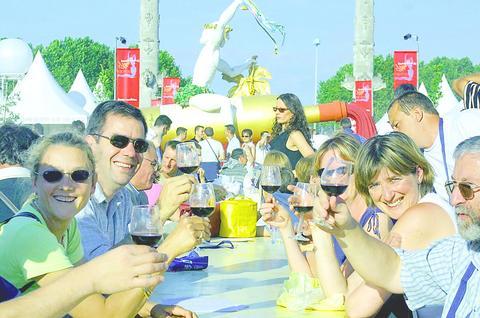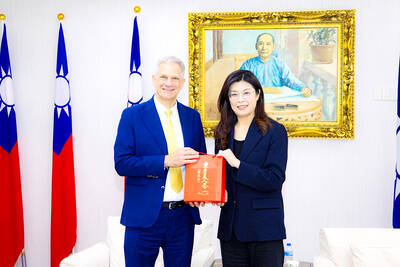The new wine is called Permis de Conduire, or Driving license, and will be marketed with a pink label which is the same color as the document that permits French people to sit behind the wheel of a car.
The wine in the 25cl bottle, the label claims, "corresponds to a concentration of alcohol not greater than 0.25mg per liter of exhaled air or 0.5 parts of alcohol to each 1,000 parts of blood, if two people share the bottle."
In other words, two people drinking one bottle of this wine will be able to drive a car without worrying about surpassing the legal limit of blood-alcohol content.

PHOTO: DPA
The wine will be launched later this month with the slogan "Keep your license."
This product is more than a clever marketing gimmick, it is evidence of an industry in deep crisis. Just like another new wrinkle in French dining -- the wine doggie bag.
Several hundred restaurants throughout the country now give their customers glossy white shopping bags with wine-colored ribbons to take their unfinished wine bottles home to "prolong their pleasure," as promotional fliers urge.
The bags are provided free of charge to restaurants by the Wine Council of Bordeaux, in response to a vigorous government program to cut down road fatalities and other alcohol-related deaths.
The objective of the program is to reduce the use of alcohol in France by 20 percent by the year 2007, and it has led to an acceleration in the decades-long decrease of wine consumption in the country.
Nowadays, the average French man and woman over the age of 15 consumes about 68l of wine per year, exactly half the amount drank in 1960, when French society considered wine a staple like bread, and considerably below the 77l per year consumed in 1990.
In addition, French wines are being squeezed on foreign markets by the so-called "new age" wines, made in South Africa, Australia, Chile and the US. As a result, exports of wines from the Bordeaux and Burgundy regions were down about 8 per cent in 2003.
The resulting accumulation of wine reserves has led to a steep drop in the barrel price of all but the most prestigious wines, which has many French vintners worried about their future.
"Today, I am earning zero," one Bordeaux winemaker said. "If that continues, I will stop."
His problem, he said, was that he can not repay bank loans taken out in the 1990s when Bordeaux wine sold for more than 1,500 euros (currently about US$1,820) per 900l barrel. Today, the price has sunk below 750 euros per barrel.
To emerge from the crisis, French winemakers have gone on the offensive, beginning with a concerted effort to reduce the amount of wine they produce.
Instead of the 7 million hectoliters they are capable of producing this year, vintners in Bordeaux have decided to destroy some of their vines and commercialize only 5 million hectoliters, hoping to force prices up.
In addition, and perhaps more important, French winemakers have embarked on a political and media campaign to change the status of their product.
A so-called "White Book" to be presented to Prime Minister Jean-Pierre Raffarin later this month declares that wine should be classified as a nutriment rather than an alcoholic beverage.
The consequence of such a change would be to exempt wine from limitations on advertising that forbid regional vintners from publicizing anything about their products but its name, alcohol content and place of sale, as prescribed by a 1991 law.
It would also permit winemakers to sponsor public events, another form of public relations currently forbidden to producers of alcoholic beverages.
Relying on a number of scientific studies, the authors of the "White Book" maintain that wine is "a food, not a drug," and that regular and moderate consumption has a number of health benefits, particularly for the cardiovascular system and in combatting Alzheimer's disease.
The editor of the White Book is Alain Suguenot, a representative in the National Assembly from the city of Beaune, in the wine region of Burgundy. He charges that French wine is being victimized by "a prohibitionist lobby that demonizes it."
"Wine," he declared, "is a product of civilization and public health that must be defended in France and abroad.

Seven hundred job applications. One interview. Marco Mascaro arrived in Taiwan last year with a PhD in engineering physics and years of experience at a European research center. He thought his Gold Card would guarantee him a foothold in Taiwan’s job market. “It’s marketed as if Taiwan really needs you,” the 33-year-old Italian says. “The reality is that companies here don’t really need us.” The Employment Gold Card was designed to fix Taiwan’s labor shortage by offering foreign professionals a combined resident visa and open work permit valid for three years. But for many, like Mascaro, the welcome mat ends at the door. A

If China attacks, will Taiwanese be willing to fight? Analysts of certain types obsess over questions like this, especially military analysts and those with an ax to grind as to whether Taiwan is worth defending, or should be cut loose to appease Beijing. Fellow columnist Michael Turton in “Notes from Central Taiwan: Willing to fight for the homeland” (Nov. 6, page 12) provides a superb analysis of this topic, how it is used and manipulated to political ends and what the underlying data shows. The problem is that most analysis is centered around polling data, which as Turton observes, “many of these

Since Cheng Li-wun (鄭麗文) was elected Chinese Nationalist Party (KMT) chair on Oct. 18, she has become a polarizing figure. Her supporters see her as a firebrand critic of the ruling Democratic Progressive Party (DPP), while others, including some in her own party, have charged that she is Chinese President Xi Jinping’s (習近平) preferred candidate and that her election was possibly supported by the Chinese Communist Party’s (CPP) unit for political warfare and international influence, the “united front.” Indeed, Xi quickly congratulated Cheng upon her election. The 55-year-old former lawmaker and ex-talk show host, who was sworn in on Nov.

Even the most casual followers of Taiwan politics are familiar with the terms pan-blue and pan-green. The terms are used so casually and commonly with the assumption that everyone knows what they mean, that few stop to really question it. The way these terms are used today is far broader and extensive than what they were originally created to represent. Are these still useful shorthand terms, or have people become so obsessed with them that they color perceptions to the point of distortion? LEE TUNG-HUI WAS NO SMURF People often assume that these terms have been around forever, or at least as